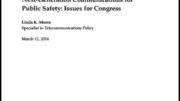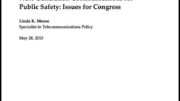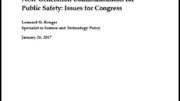Linda K. Moore
Specialist in Telecommunications Policy
June 17, 2016
Summary
Congress included provisions in the Middle Class Tax Relief and Job Creation Act of 2012 (P.L.
112-96) for planning, building, and managing a new, nationwide, broadband network for public
safety communications, by creating the First Responder Network Authority (FirstNet). The act
allocated 10 MHz of additional radio frequency spectrum to accommodate the new network and
required that the Federal Communications Commission (FCC) assign a license to FirstNet,
comprising the newly designated frequencies plus 10 MHz previously assigned to states by the
FCC for public safety use. In addition, the act designated federal appropriations of over $7 billion
for the network and other public safety needs. These funds are provided through new revenue
from the auction of licenses to the commercial sector in other spectrum bands.
The establishment of FirstNet is an important step toward reaching what has been a national goal
since September 11, 2001: the provision of interoperable communications for first responders.
The immediate goal for FirstNet is to provide a broadband network nationwide to carry data,
although it will provide an option for voice communications as well. The cost of constructing and
maintaining a nationwide network is estimated by many experts to be in the tens of billions of
dollars over the long term. The law anticipates that most of these costs will be covered by
partnerships between FirstNet and the private sector in return for commercial access to FirstNet’s
spectrum.
In order to maintain control over the quality and nature of communications, many states are likely
to continue to invest in and maintain their own Land Mobile Radio (LMR) networks that operate
on narrowband frequencies under the jurisdiction of state and local public safety agencies.
Information available to the public indicates that FirstNet intends to discourage states from
building and operating their own networks within FirstNet, in part by limiting the amount of
spectrum available for this purpose. FirstNet has taken the position that state autonomy in
network design decisions and management will jeopardize FirstNet’s ability to provide a network
that meets its coverage and service goals.
P.L. 112-96 was signed into law on February 22, 2012, setting in motion the process of setting up
FirstNet as an “independent authority within the National Telecommunications and Information
Administration,” as required by the act; laying out the parameters for partnerships, and state,
tribal and federal participation; and meeting requirements either statutory or practical. After
extensive consultation with stakeholders and potential partners in preparing proposals for
partnering with FirstNet, the initial phases of organization culminated with the deadline for
submitting proposals to build and operate the nationwide network, on May 31, 2016. The
successful bidder for the contract to build and operate FirstNet may be announced as early as
November 2016.
Once the contract is awarded, as the network becomes operational, the potential level of public
safety agency participation should be better understood, providing opportunities to evaluate the
success of FirstNet in meeting the goals Congress set for it in 2012. Among the provisions of the
act is a requirement that the Government Accountability Office, before the end of FY2022,
recommend to Congress what actions should be taken in regard to the ending of FirstNet’s
authority, mandated for review by 2027.
Congress continues to exercise vigilance in the development and deployment of FirstNet through
periodic hearings in both the House and Senate.





Be the first to comment on "The First Responder Network (FirstNet) and Next-Generation Communications for Public Safety: Issues for Congress 2016"